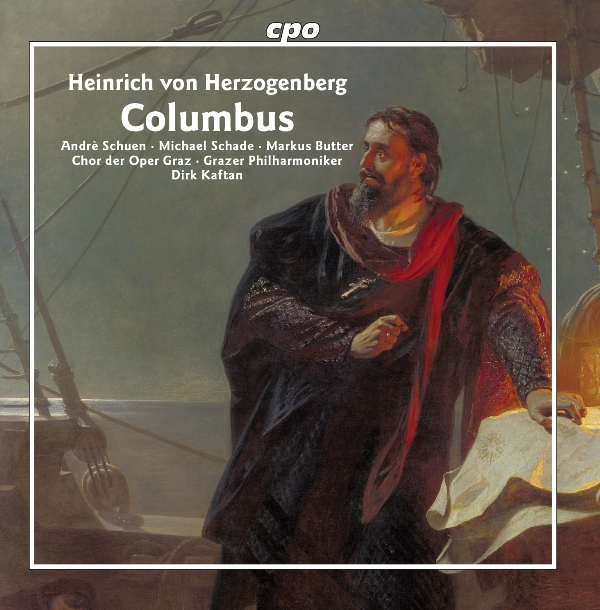
HERZOGENBERG: Columbus / Andrè Schuen, bar (Columbus); Michael Schade, ten (Fernando); Markus Butter, bar (Bootsmann); Chor & Extrachor der Opera Graz; Grazer Philharmonic; Dirk Kaftan, cond / CPO 555 178-2
Written in 1870, when Heinrich von Herzogenberg was only 27 years old, the dramatic cantata Columbus is radically different from his later, Brahms-influenced compositions. It is clearly Wagnerian in his harmonic language and scope.
Yet despite Herzogenberg’s obvious admiration for Wagner and occasional use of some of the same “transition chords” in certain passages, the melodic contour and rhythm of the music is quite different. Columbus pushes forward, from the very first note, with a greater impetus than almost any of Wagner’s early operas with the exception of Der Fliegende Holländer. Moreover, I also feel in this music some influence from Berlioz: the orchestral colors are brighter and some of the melodic construction puts one in mind of Les Troyens, which was published in the early 1860s and thus was music that Herzogenberg might have known, particularly since his family origins were actually French, not German.
However you slice it, however, the music is clearly interesting, exciting, and apropos to its grand subject. Well, perhaps we need to take its “grand subject” with a grain of salt, for despite Columbus’ obvious bravery in setting out on a long sea journey that almost ended badly, he never actually set foot in North America though, as Sarah Palin might have said, he could “see it from his rented house.” But the 19th century was a time when Latin explorers of the “New World” were lionized in operas—Spontini wrote Fernando Cortez while Meyerbeer wrote L’Africana (a.k.a. Vasco da Gama), so why not an oratorio on Columbus?
Like his musical idol of that time, Wagner, Herzogenberg wrote his own libretto for Columbus and set it to music in relatively swift fashion. This, too, was in contrast to his later self, when he spent up to a year crafting pieces in imitation of Brahms but never up to the high level of his eminent friend. Since Herzogenberg’s wife Elisabeth or Lisl, also a great friend of the British composer Ethel Smyth, was a major supporter and patron of Brahms, the famous composer hedged his words to Herzogenberg himself about the quality of these works while being more open and honest with his close friends.
The orchestra, chorus and conducting in this new recording is absolutely splendid; unfortunately Markus Butter, who sings Bootsmann, has one of those infirm-wobbly voices that drive me up a wall. What rock do they find these people under?!? And for a project of this importance, do you mean to tell me that a loser like Markus Butter was the best you could find? Well, let’s face it: no matter how terrific Columbus was, how many people do you think are going to buy this set? I’d guess a couple of thousand at most. So hey, maybe a few hundred of them like wobbly voices and think Markus Butter is the berries. Hey, at least he interprets the words, in a somewhat over-the-top manner.
Happily, Andrè Schuen, our Columbus, has a somewhat firmer voice and is an equally interesting interpreter. His first scene, “Wie wildes Wogenrollen,” has an aria-like form and is quite interesting both structurally and harmonically. And it is just at this time in the oratorio that the music really takes off, moving away from the nice but somewhat staid style of the opening two numbers and becoming much more dramatic. Herzogenberg also does something here that Berlioz did quite a bit but not Wagner of this time, which is to suddenly jump keys rather than modulate smoothly, and this, too, adds interest to the work.
Tenor Michael Schade’s voice seems to have grown in size over the years, retained its lovely tone, but now has a slight spread. It’s not as bad as Butter’s wobble, but it worries me a little. Nonetheless, the music remains interesting and grows out of its melodic cells with imagination and energy. This is clearly great music, which makes it all the sadder that Herzogenberg declined as a composer during his Brahms-worship days. With the choral passage “Rohe Gewalt,” the music becomes more conventional for a few bars, but quickly picks up its dramatic pace. Much of the oratorio, at this point, is underscored by accented whacks of the timpani. Part Two begins with a lovely cello solo that evolves into a cello-flute duet. This leads into an extended scene for Columbus, “Wie blinkt mit feuergleichen Schäumen,” which builds up from lyricism to drama and back again, modeled to some extent on the Flying Dutchman’s entrance aria, “Die frist ist Um,” despite its very original melodic line. This second part has much less choral music and many more solo passages, including a duet for Columbus and Fernando, “Genug, Fernando, sei gefasst!” Sadly, the Bootsmann makes another appearance in this section as well. But this later portion of the cantata is, again, very interesting music, turning more lyrical and less dramatic as it moves towards the finish. Just before the finale is an interesting trio for the three solo singers with chorus written in counterpoint—a nice touch. Except for the quicker tempo (and lots of timpani), the final chorus seemed to be a model for the ending of Mahler’s “Resurrection” Symphony, with its interesting rising chromatics.
All in all, I liked this piece very much. I’d give it six fish easily were it not for Butter’s wobble and the slight unsteadiness of the other two soloists, but it’s still a piece of music I wouldn’t want to live without.
—© 2018 Lynn René Bayley
Follow me on Twitter or Facebook @Artmusiclounge













